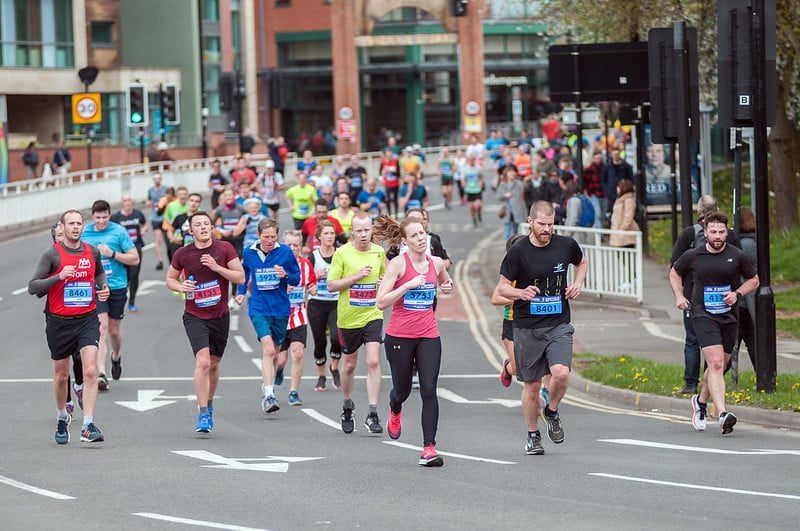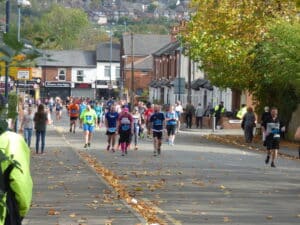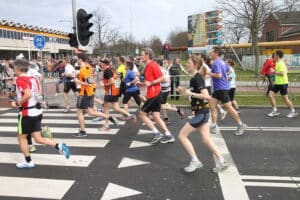There are many factors that go into what a “good” half marathon time is. It depends on many things, including age, your level of fitness, the course it’s being run on, weather, etc. Having a goal is very important to help set your paces in training, but it is incredibly important to set a realistic goal. Let’s take a look at the different factors that can contribute to setting a great half marathon time, as well as developing an attainable goal.
What Factors Can Affect a Marathon Time?
Whether it is your 1st half marathon or your 10th, your level of fitness is going to be one of the biggest contributing factors to how quickly you can run a half marathon. For obvious reasons, someone who has been training to run that far is going to have a quicker time than someone who gets off the couch a week before race day. Most people who are taking on the challenge of a half marathon are fairly prepared beforehand, but there are a few people who are able to run that far on very little training.
Two other big factors that can affect a runner’s half marathon time are age and sex. This is the reason that both are broken down into their own separate categories for all races. There will be male and female categories, as well as age groups. This way you can get an accurate representation of how you finished against other people of your age and sex, rather than against the entire field.
Elevation can be a huge factor in your time too. Some courses are perfectly flat, or even downhill (start line higher than the finish line). Other races, especially trail half marathons, can have lots of elevation changes which will greatly affect a runner’s pace.
The elites will still be able to run at a fairly steady pace, but the average runner will probably slow down or even walk on the bigger uphills. Elevation is something that should really be considered if you are looking for a race to try to set a new personal best (PB). A flat or downhill course will result in a faster race.Weather is something that is going to be different for every race, on any given day.
It is one of the variables that are completely out of our control, so it is best to prepare for as many different scenarios as possible. If the conditions are perfect, you are more likely to set a faster time. Likewise, if the weather is less than ideal (rain/snow, extreme heat or cold, etc), most runners’ pace is going to slow down accordingly.
It is very important to remember on race day to take the weather into account and adjust your race plan accordingly, if necessary. When setting goals (more on this shortly), it’s best to consider the weather possibilities for the location of your race.
The Importance of Goals
When setting a goal for a half marathon, the most important thing is to make it achievable. If an inexperienced, undertrained athlete shows up on race day hoping to set a new world record, they are setting themselves up for not only disappointment but likely an injury too.
Setting realistic goals is a very important part of any training plan. If your goals are unattainable, it can be really hard to stay motivated because you may never actually reach any of the goals you set for yourself. It is much better to set realistic goals, and then once you achieved those, aim for faster times, or harder courses.
A very common half marathon goal time is 2 hours. To finish in 2 hours or less, a runner needs to average 5:41 per kilometer for 21.1 km. This is a pretty daunting task for a newer runner, but an experienced runner who follows a good training plan and has a proper, healthy diet should be able to push for the 2-hour mark.
Another common goal for experienced runners is 1 hour 30 minutes, which means averaging 4:15 per kilometer. For a new runner that wouldn’t be a pace that would be sustainable, but for a properly trained runner, it is a completely reasonable goal. Familiarizing yourself with a pace chart [Insert Pace Chart link here] before race day can really help you nail your pacing.
A good idea when setting a goal for race day is to set 3 goals, A, B, and C. Your “A” goal is if absolutely everything goes perfect and you run a perfect race. The “B” goal is if things go well, but not perfect, but should be a time that you will still be proud of. Your “C” goal is a backup plan. A lot of people’s plan “C” is often just to finish the race. If you only have one goal, even if you miss it by a few seconds you are probably going to feel like you’ve failed.
Setting 3 staggered goals gives you the best chance of feeling accomplished at the end of the race. And if all does go well, then you can achieve all 3 goals at once! (Example: Instead of a goal of 1:45, you could have goals of 1:45, 1:55, and 2:00)

The Importance of Goals
So how do you figure out how to set your goals? There are a few different ways. If you are working with a running coach, there is a pretty good chance that you’ve already discussed your goal pace, and probably built your training around that goal. If not, your coach should be able to give you a fairly good idea of a time/pace someone with your level of fitness should be able to strive for.
Another fairly simple way is to check your fitness watch if you have one. They usually have a race predictor function that gives you a fairly accurate estimate of your race times, based on your current fitness and previous runs.
If none of these options work for you, another great option is to go out and run a 10k run (or race) and run it at your lactate threshold. Your lactate threshold is the level of exercise at which your body produces lactate faster than it can clear it away. The average person can run at lactate threshold for roughly an hour, which is perfect for a 10 km time trial. Once you’ve done your 10 km practice run, figure out your average pace over the 10 km. Your half marathon pace is going to be roughly 20-30 seconds slower per kilometer. (Example: If your 10 km pace was 5:00/km, your ideal half marathon pace is going to be somewhere around 5:20-5:30/km)
Frequently Asked Questions
Tapering is lowering your mileage in the week(s) leading up to race day so that your body is in optimal condition on race day. They are usually about 2 weeks in length for a half marathon, long enough to recover from training, but short enough not to lose fitness.
The men’s world record is 47:31, set by Jacob Kiplimo (Uganda) on November 21, 2021. The women’s world record is 1:02:52, set by Letesenbet Gidey (Ethiopia) on October 24, 2021.
A 10 km lactate threshold run is a great way to roughly figure out your estimated half marathon pace. A 5km threshold run will also work, but won’t give you quite as accurate of a pace prediction.
Absolutely! No matter what distance you are training for, every single runner will benefit from strength training as well. Working out both your upper and lower body is important, as having a strong core and good form is paramount to being a good runner. Strength training, when done properly, can also help prevent injuries by strengthing up any areas of weakness. Yoga is a great way to make sure you are stretching your entire body after a run.
If you miss some training and need to readjust your time goal, there is absolutely nothing wrong with that! You are much better off adjusting your goal accordingly so you have a chance to achieve it, rather than shooting for a goal that you know likely isn’t possible. If you find your goal is too slow once you start your training, pick a faster goal! It is important to have attainable goals to aim for.
What you fuel your body with can have a huge impact on your performance during a training cycle and a race.
When working out hard, our bodies create a by-product called “lactate.” As we exercise, our body clears the lactate out, allowing us to continue training. Once we reach a certain level of exercise, our bodies will create lactate faster than they can clear it out.
This is referred to as your “lactate threshold.” Exercising more on or over this threshold teaches our bodies to clear out the lactate faster, therefore raising your lactate threshold and making it possible to run faster for longer. There are tests you can do to determine your precise lactate threshold, although that number will change as you become more fit.
Conclusion
The most important thing when setting goals is to make sure that they are hard enough that they make you push your comfort zone, yet not outside of your realm of possibility.
If they are too hard, it can be very discouraging and that is why some runners give up running too easily. If your goals are too easy, you’ll never push your boundaries, and that is how you become a better runner. Another very important thing to remember is that every runner has a different idea of what a “good” half marathon time is.
What would be a fast time for an average runner would be seen as slow for an elite, and the times an elite can run aren’t at all possible for an average runner. Keeping this in mind when setting goals will help you become a successful half marathon runner.
RELATED ARTICLES













